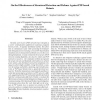Free Online Productivity Tools
i2Speak
i2Symbol
i2OCR
iTex2Img
iWeb2Print
iWeb2Shot
i2Type
iPdf2Split
iPdf2Merge
i2Bopomofo
i2Arabic
i2Style
i2Image
i2PDF
iLatex2Rtf
Sci2ools
DSN
2009
IEEE
2009
IEEE
On the effectiveness of structural detection and defense against P2P-based botnets
Recently, peer-to-peer (P2P) networks have emerged as a covert communication platform for malicious programs known as bots. As popular distributed systems, they allow bots to communicate easily while protecting the botmaster from being discovered. Existing work on P2P-based botnets mainly focuses on measurement of botnet sizes. In this work, through simulation, we study extensively the structure of P2P networks running Kademlia, one of a few widely used P2P protocols in practice. Our simulation testbed incorporates the actual code of a real Kademlia client software to achieve great realism, and distributed event-driven simulation techniques to achieve high scalability. Using this testbed, we analyze the scaling, reachability, clustering, and centrality properties of P2P-based botnets from a graph-theoretical perspective. We further demonstrate experimentally and theoretically that monitoring bot activities in a P2P network is difficult, suggesting that the P2P mechanism indeed helps ...
| Added | 20 May 2010 |
| Updated | 20 May 2010 |
| Type | Conference |
| Year | 2009 |
| Where | DSN |
| Authors | Duc T. Ha, Guanhua Yan, Stephan Eidenbenz, Hung Q. Ngo |
Comments (0)

